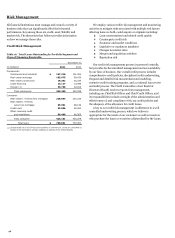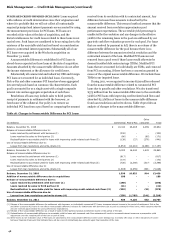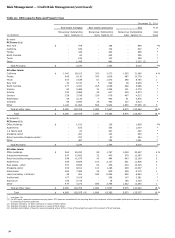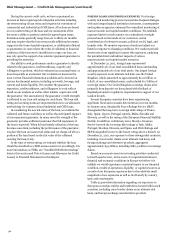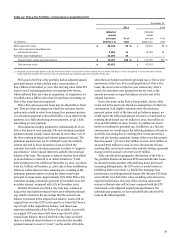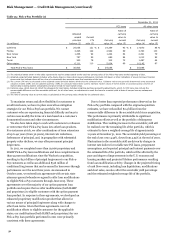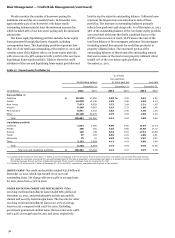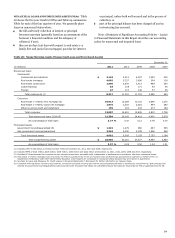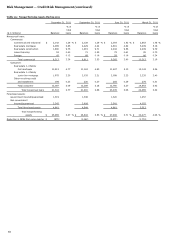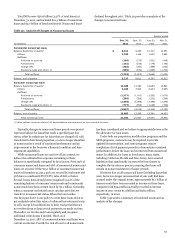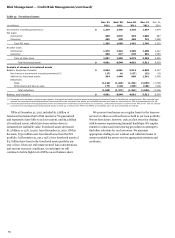Wells Fargo 2011 Annual Report Download - page 54
Download and view the complete annual report
Please find page 54 of the 2011 Wells Fargo annual report below. You can navigate through the pages in the report by either clicking on the pages listed below, or by using the keyword search tool below to find specific information within the annual report.Risk Management — Credit Risk Management (continued)
During the current credit cycle, we have experienced an
increase in loans requiring risk mitigation activities including
the restructuring of loan terms and requests for extensions of
commercial and industrial and CRE loans. All actions are based
on a re-underwriting of the loan and our assessment of the
borrower’s ability to perform under the agreed-upon terms.
Extension terms generally range from six to thirty-six months
and may require that the borrower provide additional economic
support in the form of partial repayment, or additional collateral
or guarantees. In cases where the value of collateral or financial
condition of the borrower is insufficient to repay our loan, we
may rely upon the support of an outside repayment guarantee in
providing the extension.
Our ability to seek performance under a guarantee is directly
related to the guarantor’s creditworthiness, capacity and
willingness to perform, which is evaluated on an annual basis, or
more frequently as warranted. Our evaluation is based on the
most current financial information available and is focused on
various key financial metrics, including net worth, leverage, and
current and future liquidity. We consider the guarantor’s
reputation, creditworthiness, and willingness to work with us
based on our analysis as well as other lenders’ experience with
the guarantor. Our assessment of the guarantor’s credit strength
is reflected in our loan risk ratings for such loans. The loan risk
rating and accruing status are important factors in our allowance
methodology for commercial and industrial and CRE loans.
In considering the accrual status of the loan, we evaluate the
collateral and future cash flows as well as the anticipated support
of any repayment guarantor. In many cases the strength of the
guarantor provides sufficient assurance that full repayment of
the loan is expected. When full and timely collection of the loan
becomes uncertain, including the performance of the guarantor,
we place the loan on nonaccrual status and we charge-off all or a
portion of the loan based on the fair value of the collateral
securing the loan, if any.
At the time of restructuring, we evaluate whether the loan
should be classified as a TDR, and account for it accordingly. For
more information on TDRs, see “Troubled Debt Restructurings”
later in this section and Note 6 (Loans and Allowance for Credit
Losses) to Financial Statements in this Report.
FOREIGN LOANS AND EUROPEAN EXPOSURE
Our foreign
country risk monitoring process incorporates frequent dialogue
with our foreign financial institution customers, counterparties
and regulatory agencies, enhanced by centralized monitoring of
macroeconomic and capital markets conditions. We establish
exposure limits for each country via a centralized oversight
process based on the needs of our customers, and in
consideration of relevant economic, political, social, legal, and
transfer risks. We monitor exposures closely and adjust our
limits in response to changing conditions. We conduct periodic
stress tests of our significant country risk exposures, analyzing
the potential direct and indirect impacts of various
macroeconomic and capital market scenarios.
At December 31, 2011, foreign loans represented
approximately 5% of our total consolidated loans outstanding
and approximately 3% of our total assets. Our largest foreign
country exposure on an ultimate risk basis was the United
Kingdom, which amounted to approximately $11.0 billion, or
0.84%, of our consolidated assets, and included $1.7 billion of
sovereign claims. Our United Kingdom sovereign claims arise
primarily from deposits we have placed with the Bank of
England pursuant to regulatory requirements in support of our
London branch.
Several European countries have been experiencing
significant fiscal and economic deterioration in recent months.
In January 2012, Standard & Poor’s Ratings Service (S&P)
downgraded the long-term sovereign debt ratings of France,
Italy, Spain, Cyprus, Portugal, Austria, Malta, Slovakia and
Slovenia, as well as the rating of the European Financial Stability
Facility. In addition, in February 2012, Moody’s Investors
Service lowered the sovereign debt ratings of Italy, Malta,
Portugal, Slovakia, Slovenia, and Spain, and Fitch Ratings and
S&P downgraded Greece to the lowest rating above a default. At
December 31, 2011, our exposure to these downgraded countries,
including cross-border claims on an ultimate risk basis, and
foreign exchange and derivative products, aggregated
approximately $3.4 billion, including $182.3 million of sovereign
claims.
Based on our most recent stress testing activities conducted
in fourth quarter 2011, in the event of a rapid deterioration in
financial and economic conditions in Europe we believe it is
unlikely we would experience a material impact to our financial
condition, results of operations, liquidity, or capital resources as
a result of our European exposures due to the relatively small
magnitude of our exposures as well as its diversity by country,
type, and counterparty.
Table 22 provides information regarding our exposures to
European sovereign entities and institutions located within such
countries, including cross-border claims on an ultimate risk
basis, and foreign exchange and derivative products.
52






